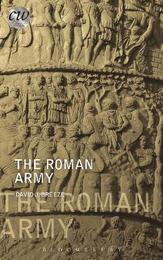
|
The Roman Army
Paperback / softback
Main Details
| Title |
The Roman Army
|
| Authors and Contributors |
By (author) David J. Breeze
|
| Series | Classical World |
|---|
| Physical Properties |
| Format:Paperback / softback | | Pages:168 | | Dimensions(mm): Height 216,Width 138 |
|
| Category/Genre | World history
Military history |
|---|
| ISBN/Barcode |
9781474227155
|
| Classifications | Dewey:355.00937 |
|---|
| Audience | | Tertiary Education (US: College) | |
|---|
| Illustrations |
25 bw illus
|
|
Publishing Details |
| Publisher |
Bloomsbury Publishing PLC
|
| Imprint |
Bloomsbury Academic
|
| Publication Date |
11 February 2016 |
| Publication Country |
United Kingdom
|
Description
This authoritative short volume introduces readers to the Roman army, its structure, tactics, duties and development. One of the most successful fighting forces that the world has seen, the Roman army was inherited by the emperor Augustus who re-organized it and established its legions in military bases, many of which survived to the end of the empire. He and subsequent emperors used it as a formidable tool for expansion. Soon, however, the army became fossilized on its frontiers and changed from a mobile fighting force to a primarily defensive body. Written by a leading authority on the Roman army and the frontiers it defended and expanded, this is an invaluable book for students at school and university level, as well as a handy guide for general readers with an interest in military history, the rise and development and fall of the Roman legions, and the ancient world.
Author Biography
David J. Breeze is an honorary professor at the Universities of Durham, Edinburgh and Newcastle. Chairman of the International Congress of Roman Frontier Studies and former Chief Inspector of Ancient Monuments, Scotland, he has written on the Roman army and on Roman frontiers, including Hadrian's Wall (4th edn, 2000), Roman Frontiers in Britain (Bloomsbury, 2013) and The Frontiers of Imperial Rome (2011).
ReviewsThis is an excellent book, immensely valuable to students and general readers, and well worth careful scrutiny by scholars. * The Classical Review * This little book is a gem. It draws together from all available sources a concise picture of the Roman army through the ages. As always, [Breeze] writes with pellucid clarity. His book is a pleasure to read ... is to be warmly recommended to everyone with an interest in Roman history or military history generally. * Classics for All Reviews * Easy to read, informative, and occasionally funny ... [Breeze] manages to cover a wide range of topics in a compact book, while discussing some at times complex and technical issues in an accessible way. * Journal of Roman Studies * A distinguished addition to a series from Bloomsbury Publishing already noted for the quality and range of its titles ... One of the book's principal achievements lies in the deftness with which information is provided, discussed and theories developed - all of it supported by a range of evidence ... Breeze is to be congratulated on the production of an informative, clear and eminently readable treatment of a complex subject. * Newsletter of the Cumberland and Westmorland Antiquarian and Archaeological Society * Breeze (Univ. of Edinburgh, Scotland) offers an accessible introduction to his subject. The book is organized both chronologically and thematically, but it neither is nor purports to be a history of the army or of Roman warfare, for which see Jonathan Roth's comparably priced Roman Warfare (CH, Oct'10, 48-1032). Breeze covers such topics as equipment, engineering, and the function of the army beyond the battlefield. Within this structure, the author refers to major battles and campaigns to illustrate specific tactical maneuvers and strategic decisions. The brief chapters discuss material culture, including archaeological discoveries, monuments, and inscriptions, from throughout the Roman Empire, as well as documentary sources. ... this book provides a clearly written and well-illustrated introduction to a topic of enduring fascination. Summing Up: Recommended. General, public, and undergraduate collections. * CHOICE * [A] glossary, thematic index and bibliography usefully complement a well-written work, offering a nuanced view of the Roman army. (Bloomsbury Translation) * Latomus * The work is rounded off by a succinct introduction which details the main kinds of sources (textual, epigraphic, sculptural, iconographic and archaeological), not forgetting the value of experimental archaeology with its reconstructions of armaments and formations. In addition to an appreciable amount of illustrations, maps, tables, a thematic index and a glossary, we're grateful for the inclusion of a list of materials to deepen the study of this subject and a bibliography segmented in themes (old sources, navy, equipment, etc.) to make a specific search easier. (Bloomsbury translation) * Desperta Ferro Antigua y Medieval * David Breeze distils a lifetime of studying the Roman army into an authoritative, short volume, packed with accurate and detailed information about all aspects of one of the most successful organisations of the ancient world. This little book provides an excellent survey of the subject for students and scholars alike. -- Boris Rankov, Professor of Ancient History, Royal Holloway, University of London, UK I can think of no one better qualified than David Breeze to write an overview of the Roman army. He has succeeded in providing a succinct account of one of the most famous armies in history which is both comprehensive and authoritative, yet very readable. -- Bill Hanson, Professor of Roman Archaeology University of Glasgow, UK
|